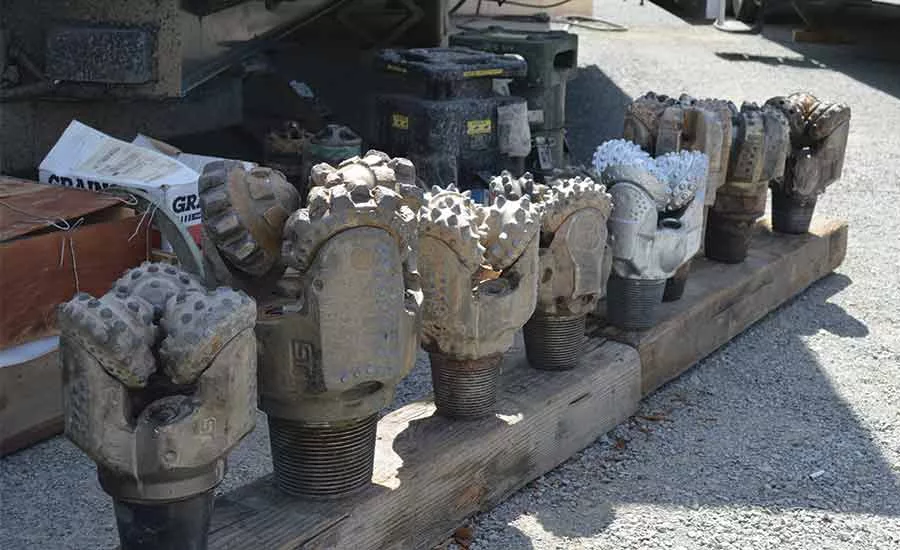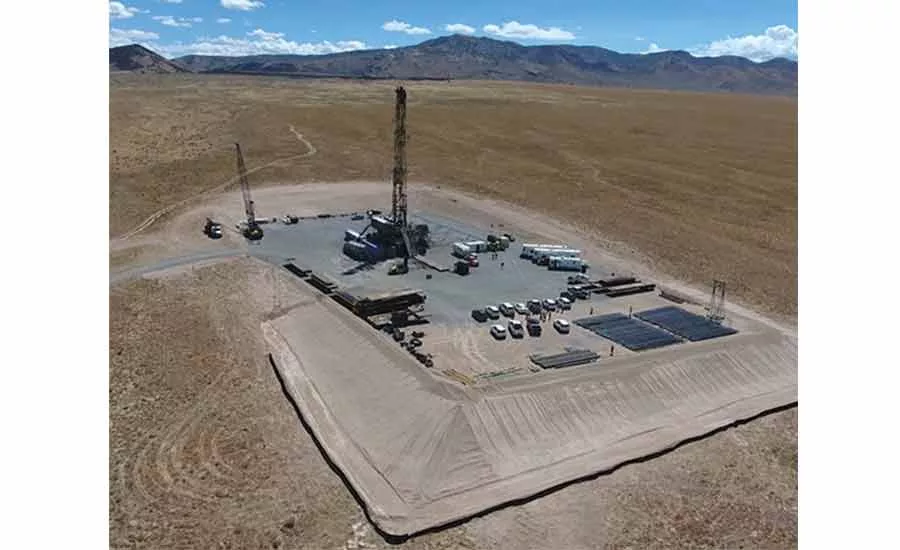A First for Geothermal Power

Drill bits from the geothermal project. There will be opportunities during the project for funded research to test new technologies and improve bit life.
Source: Gosia Skowron, EGI

In 2018 to 2019, the Utah well will be stimulated, water wells will be drilled, and ground motion and seismic monitoring systems will be established.
Source: Joe Moore, EGI

An aerial view of the FORGE Project in Milford, Utah. The site was one of five locations in the western U.S. initially selected for consideration for the FORGE laboratory.
Source: SkyHop
Mother Nature is a foe that man can’t quite conquer. However, John McLennan, associate professor of chemical engineering at the University of Utah, is ready to try.
For the last 50 years, researchers haven’t been able to access geothermal power using a closed-loop system between two wells, where cold water is injected in order to circulate through hydraulic fractures and then brought up to flash as steam. That connection between the two well pathways has never been achieved. However, with the recent popularity of directional drilling, McLennan and his team are hoping to remedy that.
After the site was selected by the U.S. Department of Energy, and Utah was granted $130 million from the federal government for research and testing, the FORGE project, or the Frontier Observatory for Research in Geothermal Engineering, will take place in Utah just outside of Milford for the next six years.
“This is a once in a lifetime opportunity that enables significant technology transfer and experience sharing with the oil and gas industry,” McLennan says.
McLennan has a storied history in the drilling industry. He has a PhD in civil engineering, and over 35 years of experience with petroleum service and technology companies. He’s worked on hydrocarbon and geothermal projects in a variety of reservoir environments throughout the world.
His current interests have focused on using the drill bit as a laboratory to determine mechanical properties of the rocks while drilling, and the physical properties of hard, hot, low-permeability geothermal reservoirs developed in granitic and metamorphic rocks characteristic of Enhanced Geothermal Systems (EGS).
National Driller had the opportunity to speak with McLennan about the FORGE project.
Q. What is FORGE? What is its mission?
A. Rocks hot enough to generate electricity can be found at drillable depths throughout the world. As shown by Jefferson Tester and his colleagues in their 2006 report, tapping even a few percent of the energy contained in these rocks is enough to satisfy the power needs of the USA.
To date, it has not been possible to extract this energy from these hot, low-permeability rocks by engineering commercial-size geothermal reservoirs. In 2014, the U.S. Department of Energy initiated the FORGE (Frontier Observatory for Research in Geothermal Energy) project to develop and implement technologies required to create an EGS reservoir in granitic rocks where temperatures exceed 175 degrees Celsius (350 degrees Fahrenheit).
The reservoir will be developed by hydraulically stimulating rocks between two deep directionally drilled wells. Fracture growth during reservoir creation will be monitored using a dense network of borehole and surface seismometers. Key research programs will focus on the following topical areas:
- Exploration technologies
- Reservoir characterization
- Lower-cost drilling
- Zonal isolation/packers
- High-temperature tools
- Stimulation procedures
- Modeling
- Diagnostics and monitoring
- Heat management techniques
- Induced seismicity
The FORGE laboratory, located in south-central Utah near the town of Milford, approximately 200 miles south of Salt Lake City, will move EGS development toward commercial viability. This site was one of five locations in the western U.S. initially selected for consideration for the FORGE laboratory. Two sites — one near Fallon, Nev., and the second at Milford — were subsequently awarded funding to prove the sites met DOE’s requirements of temperature, rock type and low risk of induced seismicity. Vertical wells were drilled at each site; at the Utah site, a temperature of 384 degrees Fahrenheit was encountered at total depth of 7,536 feet. In June 2018, the University of Utah site was chosen for the FORGE laboratory. In 2018 to 2019, the Utah well will be stimulated, water wells will be drilled, and ground motion and seismic monitoring systems will be established.
Dr. Joseph Moore is the project manager and lead for the FORGE program. He received his PhD from Pennsylvania State University in 1975 and, after graduation, worked for the Anaconda Company as a uranium exploration geologist. He holds appointments at the University of Utah as a research professor in the department of civil and environmental engineering, and as an adjunct professor in the department of geology and geophysics. Dr. Moore has worked on geothermal projects around the world since the mid-1970s. He has served as the principal investigator on numerous U.S. Department of Energy funded grants including the successful Raft River, Idaho, Enhanced Geothermal System Demonstration Project, and as a consultant to private industry, governments and international organizations.
[The] construction of the field laboratory will begin in late 2019. Two highly deviated horizontal wells will be directionally drilled. The wells will be hydraulically stimulated and a fracture network will be developed to allow injection of water into one of the wells. The heated water will be pumped out of the second well before being reinjected into the reservoir. The DOE anticipates spending $130 million over a five-year period for drilling, testing and research. Fifty percent of the funds will be used for drilling and maintenance of the facility; the remaining 50 percent will be allocated for research by the scientific and engineering community.
Q. Why is geothermal energy like this important?
A. Natural geothermal systems provide energy for electric generation and direct uses, such as space heating, in many places around the world. The U.S., Philippines, Indonesia, New Zealand and Italy are among locations where geothermal electricity is produced. Many more countries use geothermal energy for space heating and spas. Commercial operations in these locations are known as hydrothermal geothermal sites. Straight or moderately inclined wells (up to about 40 degrees) are drilled to intersect the fracture systems that allow circulation of very hot water from depth. These natural convective systems are characterized by fractures, heat and permeability.
In the U.S., natural convective systems suitable for electric generation are restricted to locations in the western part of the country. Elsewhere, the rocks lack the permeability and water required for natural geothermal systems to form. Currently, few geothermal wells are drilled to depths greater than about 10,000 feet true vertical depth (TVD); more commonly, depths are in the range of 5,000-7,000 feet. EGSs are envisioned to add these two elements. In most EGS scenarios, two or more deviated wells are drilled and interconnections between the wells are established by hydraulic injection — either by hydraulic fracturing or shear stimulation. Cold water can then be circulated down one well, [and] flowed through the extensive engineered fracture network to heat up. The heated water is then produced out of the production well. The water can be flashed to steam to drive a turbine or run through an Organic Rankine Cycle binary plant to flash an organic fluid with a lower boiling point.
EGS reservoirs allow for the extraction of heat in geographic locations away from the western U.S., where the thermal gradient is high compared to other parts of the country.
Q. Why has something like this never been successful before?
A. The concept of EGS is not new. It was first evaluated by Los Alamos National Laboratory at Fenton Hill in the Jemez Caldera in New Mexico in the late 1970s and early 1980s. During the last 40 years, numerous projects have been conducted worldwide, but the creation of reservoirs capable of producing commercial quantities of hot water comparable to natural systems has remained elusive.
Most of these EGS wells have been vertical to subvertical with barefoot completions. With near-vertical drilling trajectories, it has been difficult to develop interconnectivity between the wells through the engineered hydraulic fractures. The application of recent oil and gas experience in horizontal drilling and multistage hydraulic fracturing offers the possibility of achieving multiple connections and a large surface area in an EGS reservoir — promoting commercial viability with an amortization period of the subsurface and surface facilities over several decades.
Q. How can directional/horizontal drilling change that? What stands out about it today?
A. As indicated in the previous question, directional drilling provides the opportunity for multistage hydraulic fracturing to create nominally subparallel systems of fractures that can interconnect wells. At the FORGE site, the injection well will be drilled first and the toe hydraulically fractured. The production well will be directionally drilled to intersect the microseismic cloud detected from the hydraulic fracturing.
In other words, the ability to drill horizontal wells in a favorable direction could promote the development of subparallel fracture networks (stress shadowing among fracture stages may or may not be an issue — although proppant is typically not used, the rock is nominally impermeable). Beyond facilitating effective hydraulic fracturing, the ability to geosteer the second well into the inferred fracture network is also extremely important.
Q. What kind of tests will you run in order to see if directional drilling will work?
A. The challenges are high temperature and hard, abrasive rock. At the FORGE location, the temperature will be in a window of 175 to 225 degrees Celsius (347 to 437 degrees Fahrenheit). Drilling rates in the granitic reservoir were on the order of 10-13 feet per hour with typical bit life of 50 hours. Thread failures were common.
We will start by using proven hardened oilfield components and technology. We will be explicitly optimizing bits with extensive drill-off testing as the well is drilled. Postmortem analysis on the vertical hole also suggested the desirability for larger diameter, stiffer drill pipe, the value of using top-drive technology, optimizing the weight on bit and testing different motor technologies.
There will be opportunities for funded research to test new technologies even during the drilling to increase rate of penetration (ROP), improve bit life and optimize steering.
Q. What kinds of technology will you use, and what kinds will make a difference for this project?
A. We will enfranchise oilfield experience and consultants for the two new wells. In addition, there will be a significant effort to improve performance by more extensive use of mechanical specific energy (MSE) to refine drilling parameters. Future implementation of temperature tolerant at-bit/near-bit measurements, such as those evolving in oilfield applications, will be of real value.
Q. What do you think is the future of geothermal and directional drilling?
A. They are intimately entwined, along with high-temperature-tolerant products for stage isolation and, ultimately, for zonal shut-off/control during injection operations. There are tremendous opportunities for leveraging oilfield experience and technologies. Increasing the ability to steer geothermal wells, measure conditions at the bit, isolate portions of the wells, initiate fractures and drill highly deviated wells will have immediate applications to both EGS development and conventional geothermal fields. In conventional geothermal systems, these techniques will greatly improve our ability to connect to existing fracture networks [and] reduce the cost of geothermal drilling, which can account for up to 50-percent of the total cost of developing a geothermal reservoir.
Looking for a reprint of this article?
From high-res PDFs to custom plaques, order your copy today!





